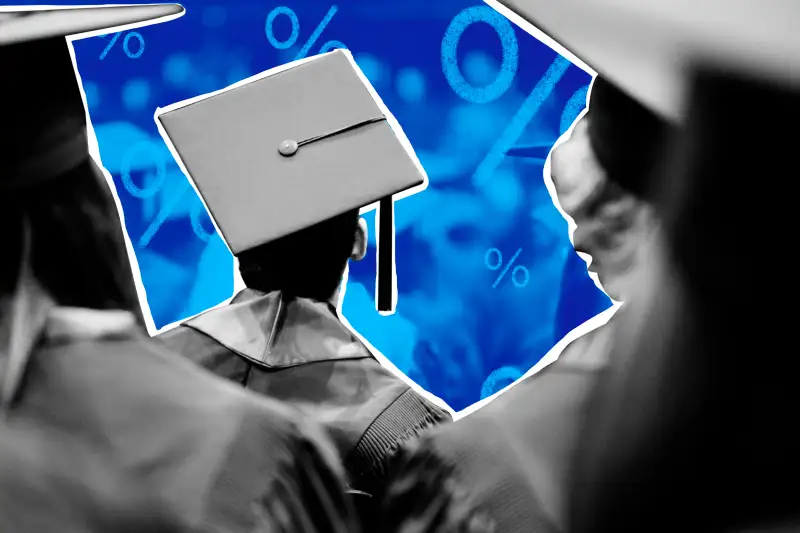Everything You Need to Know About Student Loan Interest Rates

It’s a common problem: You log in to view your student loans to see how much you owe, and are shocked to find that your loan balance is much higher than you initially borrowed. How did that happen? It’s all because of student loan interest.
Whether you're taking out your first loan or have already started repaying, understanding how interest accrues on your loans can help you avoid unpleasant surprises as you pay back your debt.
Table of contents:
- Federal student loan interest rates
- Private student loans interest rates
- How to get a lower student loan interest rate
- Student loan interest and taxes
- Interest rates: student loans vs. other types of debt
Federal student loan interest rates
When students need to borrow money to pay for college, experts recommend starting with federal student loans since they typically have lower rates and better repayment options than private student loans. Your interest rate depends on the type of loan you qualify for and the year you took out the loan.
Current interest rates on federal student loans
Below are the interest rates for federal loans for the 2023-2024 school year.
Direct Subsidized
Undergraduate students
5.50%
4.99%
Direct Unsubsidized
Undergraduate students
5.50%
4.99%
Direct Unsubsidized
Graduate students
7.05%
6.54%
PLUS Loan
Graduate students and parents of undergraduate students
8.05%
7.54%
How do interest rates work on federal student loans
With federal student loans, the rates are fixed, meaning they stay the same for the duration of your repayment term. The process for setting rates was established by Congress: the rates are based on the high yield of the 10-year Treasury Notes at auction, so the rate can change every year for new borrowers.
If you have federal subsidized loans, the government will cover the interest that accrues while you’re in college, during the six months after you graduate or leave school and during any periods of deferment. But with unsubsidized and PLUS loans, you are responsible for all the interest charges, even while you’re in school.
Interest on unsubsidized federal loans is capitalized — or added to the loan principal — when your grace period ends, so it’s common to see your balance grow unless you make large enough payments that cover the accrued interest. Interest capitalization is costly because after the capitalized amount is added to your principal, interest then continues to be charged on the new, larger balance.
Private student loan interest rates
Private student loans can come from banks, credit unions and other financial institutions. Lenders can set their own rates, but they usually base them on a measure like the Secured Overnight Refinancing Rate (SOFR) — a benchmark that influences the rates at which banks lend to one another.
Lenders will charge the SOFR rate plus a margin rate, such as 1%. As the SOFR rate changes, the lender will change its rates too.
Current private student loan interest rates
Private student loan rates vary by lender, borrower credit and loan terms. These loans can have fixed or variable rates; whereas fixed rates never change, variable rates can fluctuate over time.
Currently, private student loans have the following rate ranges:
Fixed Interest Rates*
Variable Interest Rates*
4.43% to 16.99%
5.39% to 16.99%
*Rates current as of Dec. 20, 2023.
How do interest rates work on private student loans?
Private loan interest rates can vary significantly between lenders, and your rate is influenced by your credit history, income, desired loan term and the program you are enrolled in for the upcoming semester.
With private student loans, payments are usually required while you’re in school, though you may be able to pay a reduced amount. Interest starts accruing immediately after loan disbursement.
Private lenders will capitalize the interest at different points, but how capitalization is handled varies by lender.
Keep in mind: Private loans can be a riskier form of debt than federal loans since they usually have higher rates and fewer repayment options. Exhaust your other financial aid options before turning to private loans.
How to get a lower student loan interest rate
With federal loans, there isn’t a way to qualify for a better rate; the current rates apply to all borrowers regardless of their credit or income.
Private loans work differently. Lenders base your rates on your creditworthiness, so you may qualify for a lower rate by following these tips:
- Choose the shortest term possible: Long loan terms, such as those of 10 to 20 years, can be appealing because they give you a lower payment. But to offset their risk, lenders will charge high interest rates on longer loan terms. To get the lowest rate possible, opt for the shortest term you can reasonably afford.
- Boost your credit: A few months before you need to apply for a loan, focus on improving your credit. Check your credit report and dispute any errors — you can view your report for free at AnnualCreditReport.com — make all of your recurring payments on time and minimize new credit inquiries for credit cards or loans.
- Apply with a cosigner: Most college students have limited credit histories and lower incomes, making it difficult to qualify for a loan or secure a competitive rate. If you have a relative or friend with excellent credit, ask them to cosign a loan with you. Adding a cosigner will improve the likelihood of qualifying for a low interest rate.
- Shop around: As we mentioned above, interest rates can vary significantly by lender. Shop around and request rate quotes from several lenders so you can compare your options and find the best deal. To help you get started, we identified the best private student loan lenders.
If you end up with loans with a higher rate, you may be eligible for student loan refinancing later. Refinancing your debt once you’re employed and have established good credit could allow you to qualify for a new loan with a lower rate, so it can help you save money.
Student loan interest and taxes
Student loan interest can be a pain, but there is one benefit: it may help you get a larger tax refund.
Both federal and private student loans are eligible for the student loan interest tax deduction. With this tax break, you can deduct either $2,500 of interest or the actual amount of interest you paid over one year, whichever is less. This deduction can lower your taxable income, which can lower your tax bill or help you qualify for a larger tax refund.
To qualify for the full deduction, your modified adjusted gross income (or MAGI) must be less than $70,000 ($145,000 if you’re married filing a joint return). You may qualify for a reduced deduction if your income is between $70,000 and $85,000 ($145,000 and $175,000 if you’re married filing jointly). You aren’t eligible for the deduction at all if your income is over $85,000 ($175,000 for joint filers).
How to claim the student loan interest tax deduction
If you paid $600 or more in interest, your lender will send you a Form 1098-E, Student Loan Interest Statement, which you can use to claim the deduction. It’s an above-the-line deduction, so you can qualify for the student loan interest deduction even if you don’t itemize your deductions.
Student loan interest vs. other loans
Student loans — particularly federal loans for undergraduate students — tend to have lower interest rates than other forms of debt. For example, these are the current rates for common forms of credit:
Car loans with 72-month terms
8.12%
Personal loans with 24-month terms
12.17%
Credit cards that assess interest
22.77%
Mortgages with 30-year terms
6.95%
Sources: Federal Reserve and Freddie Mac. *Rates current as of Dec. 20, 2023.
Student loan interest rates FAQs
What is a good interest rate on student loans?
Which federal student loans have the highest rates?
How is student loan interest calculated?
More from Money:
Here's How Much of Your Income Should Go to Student Loans Each Month

